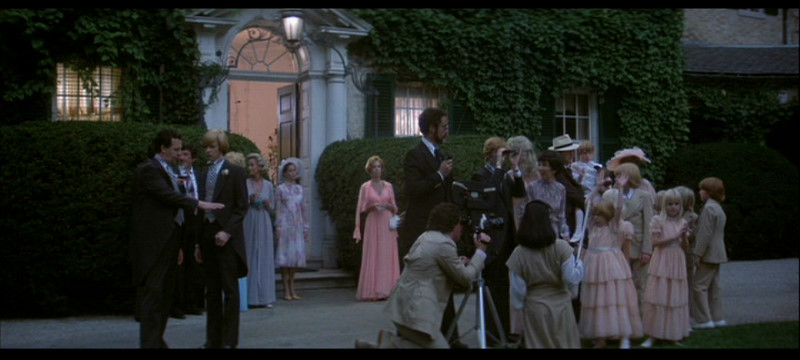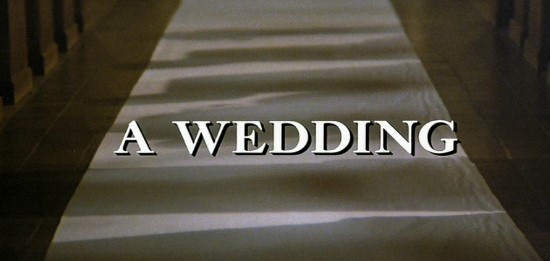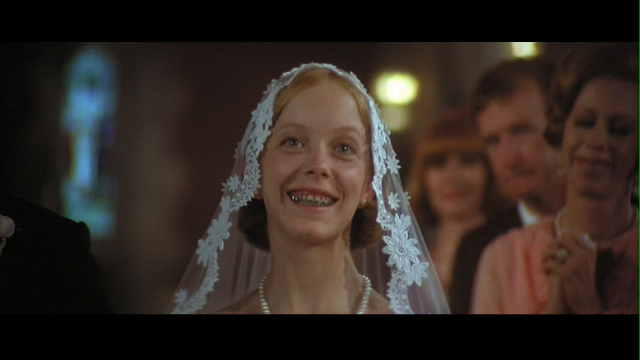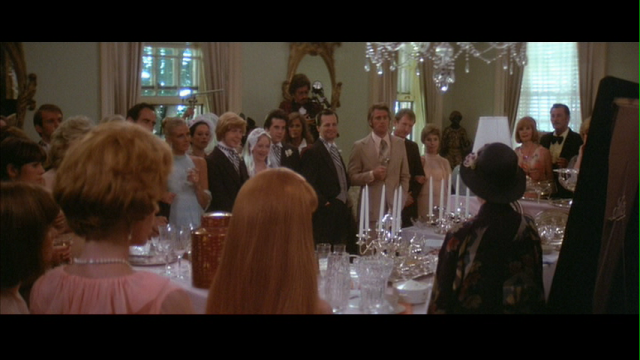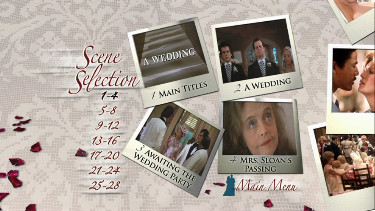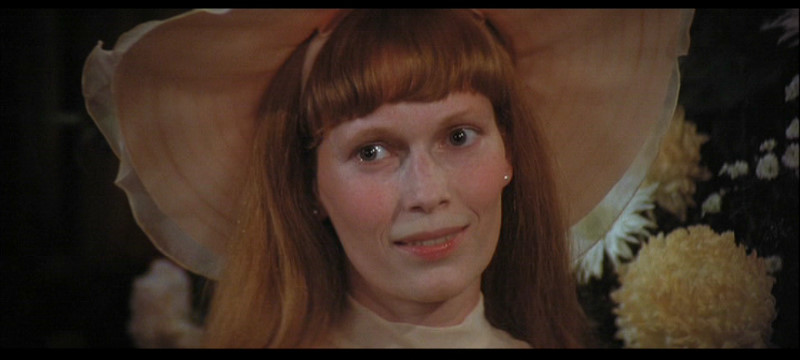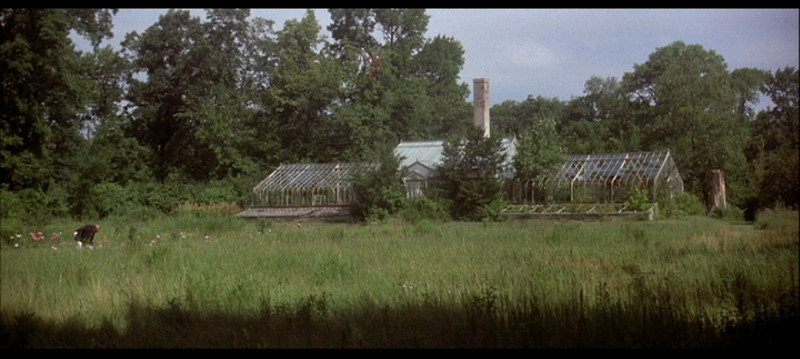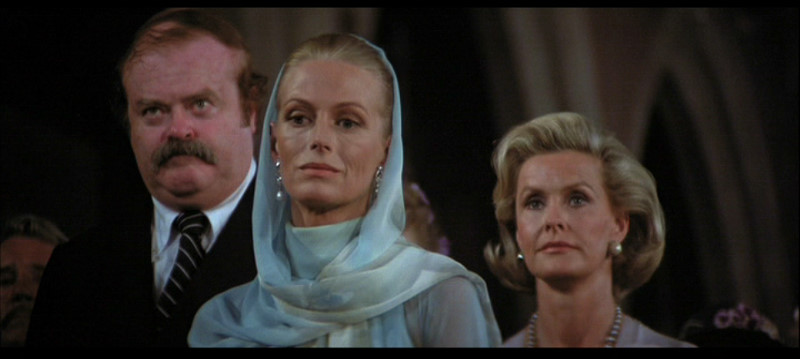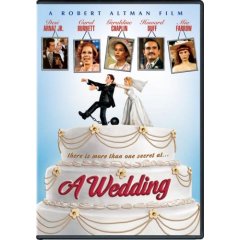From the September-October 1978 issue of Film Comment. — J.R.
An Altman
By Jonathan Rosenbaum
Doubling the number of featured players in Nashville from twenty-four to forty-eight while shrinking the time scale from three days to one, A Wedding offers an extension rather than an expansion of Robert Altman’s behavioral repertory. Variations on the same dirty little secrets, social embarrassments, and isolating self-absorptions that illustrate his last ten movies are trotted out once again -– articulated as gags or tragicomic mash notes, molded into actors’ bits, arranged in complementary or contrasting clusters, orchestrated and choreographed into simultaneous or successive rhythmic patterns, and strategically timed and placed to coincide with unexpected plot or character reversals.
The execution of these pirouettes has never presented critics with much of a problem, for the level of craft is pretty consistent. (Some gags are funnier than others, but all get the same careful/offhand inflection.) What remains a bone of contention is their justification, which shifts more discernibly from film to film. M*A*S*H’s was that war could be fun while Brewster McCloud’s said that escape was impossible; Images and 3 Women depended on shopworn arthouse symbols while Nashville and Buffalo Bill and the Indians put the American flag to comparable use. If gambling (California Split) and a critical engagement with genre conventions (McCabe and Mrs. Miller, The Long Goodbye, and Thieves Like Us) seemed to offer more lasting rationales behind these collections of Altman-turns, this might be because their premises were less abstract and banal, and more tied down to concrete understandings. Nashville can’t easily qualify as a statement about America if it doesn’t pass muster as a portrait of its title city, and I doubt that Buffalo Bill is any more knowledgeable about Indians –- although both seem to qualify as fairly hip movies about show business as long as they stay on that subject.
What’s the subject of –- and justification for -– A Wedding? It’s hard to say precisely, but it seems perched somewhere between weddings in general (another abstraction) and one wedding in particular, i.e. Southern nouveau-riche bride marries groom from established Midwestern aristocracy, a Catholic ceremony followed by a reception and party at the estate of the groom’s family. I’m grateful that the movie isn’t called Chicago and doesn’t wave any more rhetorical flags in my face, and would be quite happy to accept the wedding and party as a motor and catalyst for Altman’s interacting pirouettes — if that’s all I were being asked to accept.
But something tells me that Altman wants me to accept something more -– specifically, a few reverse zooms away from the façade of the church and family mansion accompanied by solemn brass fanfares. Are these shots assertions of a Big Statement or mockeries of such assertions? The question is academic, because they invariably register as both, despite the fact that the referent remains vague. The implication is that Altman has something important to say, even though he can’t quite believe it and isn’t quite sure what it is.
I’d like to offer Altman an escape clause from the weighty demands that some critics have been placing on him, and propose that style is the subject of and the justification for most of his work — for better and for worse, and in A Wedding most of all. How we come to terms with this is our problem as well as his; a few suggestions are offered below.
If the streets of Altmanville are paved with style and peopled with charming visitors and residents, the urban planning behind the whole complex still has some of the communal formlessness and pathos of condominiums and shopping malls. Families in Altman films nearly always have something makeshift and jerry-built about them, similar to most film crews — temporary arrangements made by restless nomads.
The Corelli family in A Wedding, which is supposed to be relatively fixed and stable, comes across as an awkward cipher of dissimilar parts that never quite match up: a matriarchal grandmother (Lillian Gish) with a socialist sister (Ruth Nelson) and three daughters (Dina Merrill, Virginia Vestoff, Nina Van Pallandt), the latter a drug addict married to an Italian rumored to have Mafia connections (Vittorio Gassman) and the mother of the groom (Dezi Arnaz Jr.) and his twin sister (Belita Moreno).
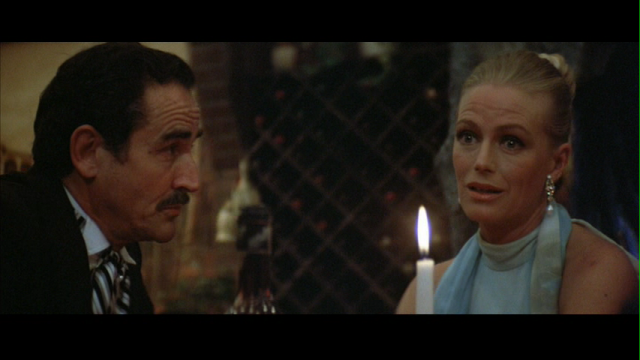
As a static entity, this family never really convinces or coheres, perhaps because they appear to be composed in relation to the dynamics of the scattershot plot, which is composed in turn in order to produce pirouettes. The grandmother propitiously dies just as the first guests are arriving, setting up a whole chain of deceptions and embarrassments; Vestoff is having a secret affair with a black servant (Cedric Scott), which provides a few more; Merrill runs a factory, which occasions debates with her socialist aunt; and the groom, who met the bride in Louisville, has allegedly impregnated her sister (Mia Farrow) — furnishing a fresh set of complications.
If the Brenners, the bride’s trucker family, have slightly more collective coherence, this may be in part a function of their own dislocation, Southern accents included, which bring them closer to Altman’s imaginative range. Yet they too seem formed by expediency designed to provoke some of his specialties. The bride’s mother (Carol Burnett), already looking primed for a reprise of Lily Tomlin’s sensitive performance in Nashville, encounters a sudden declaration of love from Merrill’s husband (Pat McCormick); we know in advance that she’ll wind up shedding some resistance, if only to produce the kind of performance that Altman wants.
Or consider Hughie (Dennis Christopher), the bride’s likable kid brother. When he swallows a lot of pills at the party and explains to a Corelli that they’re for his epilepsy, my smirking assumption — already conditioned by the Altman context — is that this is a cover story for uppers or Quaaludes. Much later, after the honeymoon car crashes into a fuel truck and the wedding couple are believed to be dead, an ugly quarrel breaks out between the families, seething with class resentments, until Hughie — passionately echoing my own conditioned sentiments at this point — screams, “Will you all shut up? They’re dead!” Then, after tearfully describing the wreckage that he saw, he has an epileptic seizure — in a shot that Altman “tastefully” cuts short. Before I can recover from this, the wedding couple appear, alive; it turns out that the real victims of the accident were the former lovers of each, characters that the film has already conditioned me not to give two hoots about. In algebraic terms, smirk + anti-smirk + false disaster + real disaster = 0. All I’m left with is a nice kid who has epilepsy.
Moving through this charted space like a visitor shoved through a package tour, one is not encouraged or even permitted to settle down; movement itself becomes the purpose of the trip, the nature and sum of this movement the director’s signature. Unlimited virtuosity is exercised on a limited terrain, where any possibilities of sustained reflection are thwarted for the sake of glancing cameos and theatrical turnarounds.
Faced with a group of people who can’t plausibly behave like a film crew — except for an “actual” film crew (Lauren Hutton and others), plunked into the wedding and party for no discernible reason — Altman reaches for petrified models from other movies: a Corelli suggested by Brando’s Corleone in The Godfather, addressing a female corpse in a manner recalling Brando’s in Last Tango in Paris; an adulterous greenhouse rendezvous out of Rules of the Game; a car wreck from Contempt. One could play the game endlessly, speculating about the Griffith “miscegenation” theme alluded to in Lillian Gish’s scene with Cedric Scott, the merry-go-round of cars from Playtime (minus Tati’s acute sense of scale and timing), and perhaps even Beverly Ross’s nervous nurse as an echo of Juliet Berto in Celine and Julie Go Boating. The trouble with such references — which also proliferate in The Long Goodbye — is that they’re never more than nostalgic touchstones. Like Bogdanovich’s and Truffaut’s and unlike Godard’s and Rivette’s, they never add critical insights to the originals, functioning instead as postage-stamp reproductions designed to fill up empty spaces.
“Whatever its sophistication, style has always something crude about it: it is a form with no clear destination, the product of a thrust, not an intention, and, as it were, a vertical and lonely dimension of thought. Its frame of reference is biological or biographical, not historical: it is the writer’s ‘thing,’ his glory and his prison, it is his solitude. Indifferent to society, and transparent to it, a closed personal process, it is in no way the product of a choice or of a reflection on Literature. It is the private portion of the ritual, it rises up from the writer’s myth-laden depths and unfolds beyond his area of control.”
A central practice of American auteurist criticism has been a concentration of style in isolation from form. Perhaps because the very notion of a stylistic decision is more compatible to marketplace tactics than to art-making strategies, the analytical realm of the formal decision gets unwittingly expunged from criticism, and distinctions between art and commerce become hopelessly confused.
It has apparently been within the terms of this confusion that a director like Altman can be assigned the status of “modernist” — a term that can be made to apply to his work only after the concept has been stripped of its historical meaning, and used as a synonym for modern, contemporary, or alienated/ European/jaded/skeptical/self-conscious (pick one). Precisely because workaday auteurism has chosen to operate without a modernist canon (ignoring the work of Akerman, Duras, Godard, Rainer, Rivette, Snow, Straub/Huillet, and others whose strategies depend more on formal decisions), it is understandable why an attempt would be made to enlist someone like Altman as an entertaining replacement. Yet as long as he is perceived and celebrated as a stylist, the effort is foredoomed, for reasons suggested by the passage from Roland Barthes’ Writing Degree Zero quoted above. And if anything about Altman’s work is clarified by A Wedding — simultaneously one of his richest and thinnest movies — this is that it can’t be celebrated or defended any other way.
Gish’s matriarch is a luminous icon, Paul Dooley’s father of the bride a hard-sell caricature, his wife (Burnett) an intriguing complex of shifting layers, wonderful when she gives herself sexy looks in a mirror. Some of the gags are ludicrously overloaded: Burnett and McCormick’s greenhouse tryst is invaded by kids and she pretends to lose an earring — “First one who finds it gets a quarter”; McCormick chimes in, “Make that a hundred dollars.” But Belita Moreno’s explanation to a guest that she doesn’t share a room with her twin brother — a subtle mixture of tactful patience, snobbery, and awesome self-possession in the delivery of her monosyllabic lines — is a moment of quiet perfection. The unwitting wake where the bishop (John Cromwell) addresses Gish is another. Yet what about the homosexual advances made successively to the bride and groom — a “gag” executed with sniggering offensiveness, reminding me of the treatments afforded lesbians in That Cold Day in the Park and a transvestite in California Split?
Good, bad, and indifferent, they all get dutifully pasted into Altman’s family scrapbook, an album that could well be titled, “What We Did at Summer Camp”. (“When it’s over, it gets real sad,” the film’s closing line, refers to more than just weddings; it’s a campfire farewell.) The sheer unevenness of the items is such that we either have to divvy up the spoils into good and bad piles — which threatens to become tedious — or try to adopt a different way of dealing with all of them.
This instability of response has a lot to do with what keeps Altman’s movies interesting, at least as long as we’re watching them — one thing that I believe separates his marijuana drifts from the cocaine conceits of many of his colleagues. It’s only after the roller coaster stops that we can evaluate whether the ride was worth taking. Whatever my misgivings, when I think about what most of the rest of the Hollywood carnival wants me to do with my time and money, I’m tempted to brave the tracks once more. At least it beats cotton candy and pinball.

